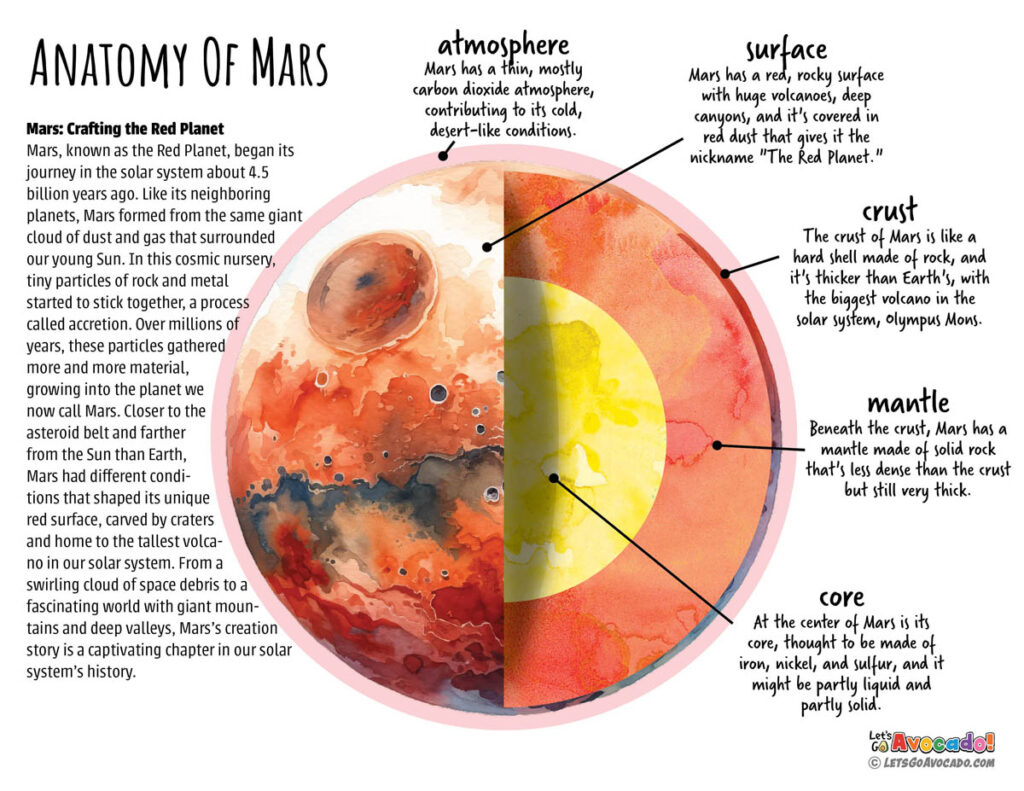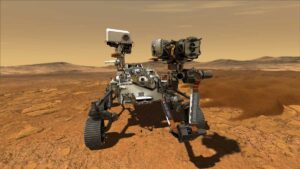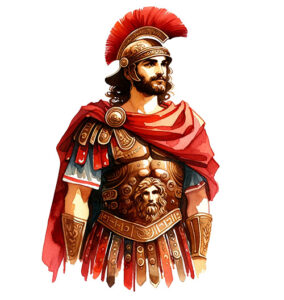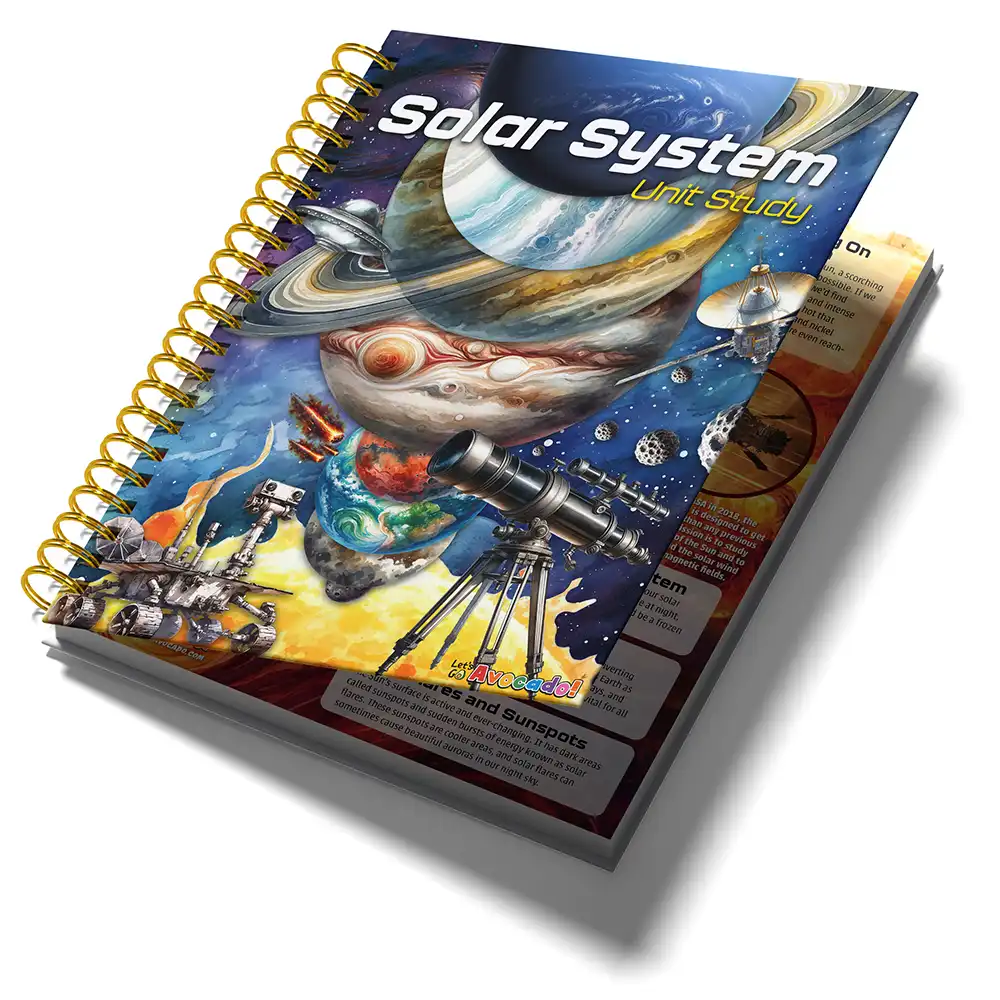This page may contain affiliate links.
Read our disclosure and privacy policy here.
Mars is famously known as the Red Planet, and this characteristic color isn’t just for show. The surface of Mars is covered with a fine dust of iron oxide, or what we commonly call rust. This rust reacts with the sunlight, casting a reddish glow that makes Mars distinctly visible in our night sky. This unique feature sparks curiosity and wonder, illustrating how even the smallest details, like the composition of surface dust, can define the identity of an entire planet. Let’s dive in an learn more facts about Mars!
Table of Contents
The Red Planet – Get The Facts About Mars
The Structure Of Planet Mars

This anatomy poster is available in our Solar System Study Unit. Check our downloads section for more details.
The Crust: Mars’ Rocky Surface
Mars is wrapped in a solid crust, not just rocks and dust, but also home to the tallest volcano and the biggest canyon in the solar system. This crust tells us stories of water that once flowed, shaping valleys and plains, hinting at Mars’ watery past.
The Mantle: The Middle Layer
Beneath the crust lies Mars’ mantle, a layer made of solid rock that can move very, very slowly. It’s like the thick middle layer of a cake, sitting right under the crust and above the core, helping to shape the planet’s surface over millions of years.
The Core: The Heart of Mars
Deep inside Mars, we find its core, a dense ball made mostly of iron and nickel. This core is fascinating because it’s thought to be partially liquid. It’s the core’s job to give Mars most of its weight and play a part in creating Mars’ magnetic fields, even though they’re not as strong as Earth’s.
The Atmosphere: Mars’ Thin Air
Now, let’s talk about the air around Mars, or its atmosphere. Mars’ atmosphere is super thin and mostly made of carbon dioxide, with tiny bits of nitrogen and argon. Even though it’s too thin for humans to breathe, this atmosphere is strong enough to support weather, including wind and dust storms that can cover the whole planet!
The Martian Atmosphere: Thin but Dynamic
Water on Mars: A Watery Past
Mars' Moons: Phobos and Deimos
The Martian Surface
Exploring Mars: Robots on the Red Planet

The Perseverance rover was launched in July 2020 and landed on Mars in February 2021. It’s main mission is to look for signs of life.
Living on Mars: Looking to the Future
Mars in Cultural Mythologies and Folklore

The planet Mercury was named after the Roman god Mercury, the messenger of the gods. The god Mercury was also known as Hermes in Greek mythology.
Fun Facts About Mars
- Mars is Home to the Tallest Mountain: Olympus Mons is the tallest volcano and mountain in the entire solar system. It’s about three times the height of Mount Everest, Earth’s tallest mountain. Imagine standing at the bottom and looking up; it would be like seeing a mountain that reaches into the sky!
- Mars has Giant Dust Storms: Sometimes, Mars experiences dust storms that can cover the whole planet! These storms can last for months and make the entire planet look like it’s covered in a red haze. It’s like the planet playing hide and seek with us.
- Mars’ Soil Could Have Water: Scientists have found signs that there might be water in the soil of Mars. This water isn’t flowing like a river but mixed into the soil, kind of like how a sponge holds water. This is super interesting because where there’s water, there might have been life!
- Mars has Two Moons: Unlike Earth, which has one moon, Mars has two small moons named Phobos and Deimos. They’re much smaller than Earth’s moon and are thought to be captured asteroids from the asteroid belt. It would be quite a sight to see two moons in the sky at the same time!
- It’s Known as the Red Planet: Mars is often called the Red Planet because of its reddish appearance, which is due to iron oxide, or rust, on its surface. If you were to visit Mars, everything around you would have a red tint, making it look very different from Earth.
FAQ: 10 Common Questions About Mars
- Why is Mars called the Red Planet?
Mars is called the Red Planet because its surface is covered in iron oxide, or rust, which gives it a reddish appearance. This rust makes Mars look red in the sky to us on Earth. - Can people live on Mars?
Right now, Mars isn’t a place where people can live because it has very cold temperatures, hardly any air to breathe, and no liquid water. Scientists are studying Mars to see if humans could live there in the future with the help of special equipment and habitats. - Does Mars have any water?
Mars has ice water at its poles and sometimes frost on the surface. Scientists have also found signs that liquid water might flow under its surface during certain seasons. - What are Mars’ moons like?
Mars has two small moons named Phobos and Deimos. They are irregular in shape, like tiny potatoes, and are much smaller than Earth’s moon. They might be captured asteroids from the asteroid belt. - How long is a day on Mars?
A day on Mars, also called a sol, is just a little longer than a day on Earth. It’s about 24 hours and 39 minutes long. - What’s the tallest mountain on Mars?
The tallest mountain is Olympus Mons, a huge shield volcano. It’s about three times the height of Earth’s Mount Everest, making it the tallest volcano in the solar system. - Are there any robots on Mars?
Yes, there are robots called rovers, like Curiosity and Perseverance, exploring Mars right now. They move around the surface, taking pictures, and sending back information for scientists to study. - What’s the weather like on Mars?
Mars has seasons, wind, and sometimes huge dust storms that can cover the whole planet. It can get very cold, with temperatures dropping way below freezing. - Could there be aliens on Mars?
So far, scientists haven’t found any signs of aliens or current life forms on Mars. They are looking for signs of past microbial life, which means really tiny life forms that might have lived there millions of years ago. - Why do scientists study Mars?
Scientists study Mars to learn more about planets and how they work, including Earth. They’re interested in Mars’ history, its potential for water and life, and how it’s similar or different from Earth. This helps us understand more about our own planet and the possibility of living on other planets in the future.
References
For those eager to dive deeper into the facts about planet Mars, here are some highly recommended resources that offer a wealth of engaging and educational content:
- NASA’s Mars Exploration Program: Offers comprehensive facts about Mars, including its atmosphere, gravity, temperature, and more, in an interactive and educational format. It’s an authoritative source for up-to-date information directly from the leading space exploration organization. Visit NASA’s Mars Facts
- Space.com – Mars: Facts and Information About the Red Planet: Space.com is generally known for its reliable and engaging content on space-related topics. It often includes visuals, which can help in explaining complex concepts to kids. Check our this article on mars.
These resources are perfect for expanding your knowledge and are sure to spark further curiosity and learning.

There’s a lot to explore right where we are, in our own neighborhoods and backyards! Join us while we get off the couch and explore the everyday wonders of nature, science, space, engineering, art, and anything else we stumble upon during on our adventures.




